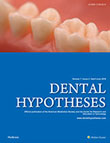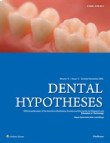فهرست مطالب

Dental Hypotheses
Volume:7 Issue: 2, Apr-Jun 2016
- تاریخ انتشار: 1395/04/02
- تعداد عناوین: 9
-
Page 34IntroductionAyurveda is the ancient Indian system of health care and longevity. Ayurvedic treatment is aimed at the patient as an organic whole, and treatment consists of salubrious use of drugs, diets, and certain practices. Currently, Ayurveda is widely practiced in the Hindustan peninsula (India and the neighboring countries) and in recent years, there has been a resurgence of herbs in economically developed countries such as those in Europe, United States, and Japan.MethodsA comprehensive literature search was made in PubMed, MEDLINE, LILACS/BBO, Cochrane Database of Systematic Reviews, sciencedirect, and Google Scholar databases.ResultsHerbs have been used for centuries to prevent and control disease. Herbal extracts are effective because they interact with specific chemical receptors within the body and are in a pharmacodynamics sense, drugs themselves. Taking into consideration the ineffectiveness, potential side effects, and safety concerns of synthetic drugs, the herbal alternatives for dental usage might prove to be advantageous.ConclusionPhytomedicine has been used in dentistry as an anti-inflammatory, antibiotic, analgesic, sedative and also as endodontic irrigant. Herbal preparations can be derived from the root, leaves, seeds, stem, and flowers.Keywords: Dentistry, phytomedicines, toxicity
-
Page 42IntroductionStem cells (SCs), known as cells with characteristics such as self-renewal and multilineage differentiation, are generally obtained from two sources: Embryonic stem cells (ESCs) and adult stem cells (ASCs). SC research is expected to play a pivotal role in future medicine. The aim of the present review was to introduce dental and nondental SCs, examining the general characteristics, in vivo and in vitro differentiation capacities, immunosuppressive properties as well as the application of SCs in dentistry and regenerative medicine.MethodsIn October 2015, PubMed, Scopus were searched by experienced researchers with the query "stem cells and dentistry "and a focus on SC and dental journals.ResultsIn the field of dentistry, ASCs, isolated from different structures, are divided into different subpopulations: Dental SCs, population of SCs isolated from different components of immature and mature teeth and nondental SCs, and those isolated from oromaxillofacial tissues.ConclusionsIt appears that dental and nondental SCs are popular resources of SCs because of easier accessibility and fewer ethical problems. In addition, they have a high differentiation capacity into different cell lineages. Different studies have introduced dental and nondental SCs as suitable SC sources for SC therapy in dentistry and regenerative medicine.Keywords: Adult stem cells (ASCs), dental stem cells (DSCs), nondental stem cells, regenerative medicine, stem cell (SC)
-
Page 56IntroductionOne of the most common side effects of bisphosphonate intake is osteonecrosis of the jaw (ONJ) which may develop following dentoalveolar interventions. Despite the vast available protocols, there is no clear guideline in the management of this condition. In osteonecrosis, the number and proliferation of bone-forming cells as well as vascularity are disturbed. Erythropoietin (EPO) is a hematopoietic hormone with angiogenic, osteogenic, and antiapoptotic properties.
The Hypothesis: It is suggested to utilize poly lactic-co-glycolic acid hydrogel containing 1500-3000 IU/kg EPO following dentoalveolar surgery in samples receiving bisphosphonates as a preventive or therapeutic agent.
Evaluation of the Hypothesis: Considering the pathophysiology of ONJ and therapeutic properties of EPO, it is assumed that EPO may be effective in treatment of ONJ. Furthermore, as a preventive measure, utilizing EPO following dentoalveolar surgery may be beneficial in the patients at risk of ONJ.Keywords: Bisphosphonate, erythropoietin, osteonecrosis of the jaw -
Page 61IntroductionThough a large number of agents including chlorhexidine have been used for cavity disinfection during restorative procedures, till date none has proved to be "ideal." Thus, there is a need for an alternative cavity disinfectant, which is safe, effective, and economic. Herbal extracts of Aloe vera and propolis have shown the potential to be used as cavity disinfectants but not much is known about them. The aim of this study was to evaluate and compare the antibacterial activity of ethanolic extracts of Aloe vera and propolis against S. mutans and L. acidophilus, along with assessing the minimum inhibitory concentration (MIC) and minimum bactericidal concentration (MBC).Materials And MethodsThe study included three groups: 2% chlorhexidine solution (group I), ethanolic extract of Aloe vera (group II), and ethanolic extract of propolis (group III). An MIC test was carried out using tissue culture microplates and serial dilution technique and later to MBC, an aliquot of each incubated well with concentrations higher than MIC was subcultured on brain heart infusion (BHI) medium. Antibacterial assay was carried out using agar disk diffusion technique and zones of inhibition were determined. One-way analysis of variance (ANOVA) was used for intergroup comparison followed by post hoc Tukey's test for groupwise comparison.ResultsGroup II and Group III showed bacteriostatic effect but no bactericidal effect against both S. mutans and L. acidophilus. There was a significant difference in the antibacterial activity against both the tested microorganisms among all the groups, the highest being in group I followed by group II and group III.ConclusionsEthanolic extracts of Aloe vera and propolis are only bacteriostatic and their antibacterial efficacy is inferior to chlorhexidine against both S. mutans and L. acidophilus.Keywords: Aloe vera, antibacterial, cavity disinfection, chlorhexidine, dental caries, disinfection, minimum bactericidal concentration (MBC), propolis
-
Page 63IntroductionThree-dimensional (3-D) printing is seen as an innovative production process in many fields of dentistry and medicine. But implantation of this novel production process into the treatment of decayed teeth in dentistry remains lacking. Destruction of dental tissues as a result of dental caries is generally treated with dental resin composite fillings. However, a 3-D-printed tooth filling approach, which could be an alternative to traditional approaches, has a potential to reduce treatment costs and technique-sensitivity of the placement of restorative material.
The Hypothesis: Here, the hypothesis that a 3-D-printed tooth filling approach could be an alternative to traditional approaches to treatment of decayed teeth is proposed.
Evaluation of the Hypothesis: The actual implementation of the 3-D-printed tooth filling technique in the practice of restorative dentistry was discussed in this manuscript.Keywords: Three, dimensional (3, D), printing, dental filling, dental caries -
Page 67IntroductionEpulis fissuratum is a tumor-like hyperplasia developing in association with an ill-fitting denture.
Case Report: We report a 73-year-old female with epulis fissuratum in the soft palate as a very rare clinical location. She presented with the chief complaint of an abnormal growth along the posterior border of her ill-fitting upper complete denture as well as pain and discomfort during mastication. Intraoral examination revealed a polypoid fibrous mass, soft in consistency and smooth in texture. On history and clinical examination, a provisional diagnosis of denture-induced hyperplasia was made. The patient was prescribed topical anti-fungal medications for 10 days. Then, the lesion was excised surgically.DiscussionHistopathological examination revealed hyperplastic epithelium as well as a fibrous connective tissue with moderate inflammation which confirmed the clinical diagnosis. Although rare, epulis fissuratum can happen along the posterior portion of the upper denture and should be considered in intraoral examination.Keywords: Denture, induced hyperplasia, epulis fissuratum, soft palate -
Page 70Underserved patients are at the highest risk for oral and overall health complications due to the many obstacles that prevent the group from receiving the most basic forms of health care. Receiving orthodontic care is even scarcer since most dental insurances regard it as an elective treatment, and only a limited number of orthodontists will treat these patients. The situation only worsens, as it appears that orthodontists in training intend to see even less of these patients in the future. Considerable changes need to be made. One change that needs to occur is within the dental training and education orthodontists receive. There needs to be a transition that encourages and promotes the development of skills necessary for treating underserved patients. Another change needs to occur in the restrictions that prevent specialists from participating in programs designed to provide relief in underserved areas. The events that would follow this change demonstrate the necessity for revisions in prohibitive policies against specialists. Finally, an initiative is needed to decrease costs associated with orthodontic treatment to make treatment more accessible, especially for patients with U.S. federally funded healthcare - Medicaid. Encouraging limited orthodontic treatment in mixed dentition (Phase I treatment) could aid in resolving this issue. The worsening situation among the underserved is connected to an unsustainable status quo. These issues need to be addressed and resolved to prevent any further onset and begin recovery.Keywords: Dental education, interceptive treatment, Medicaid, student debt, underserved


